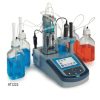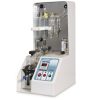So2 in Oenology
Oxidation is the term used by chemists to describe when an element or compound loses electrons; oxygen is often involved in this process because it readily accepts one or more electrons when it reacts with an element or compound.
We have seen that oxidation during grape harvesting is of an enzymatic type while in subsequent processes it is of a non-enzymatic or chemical type.
SO
2 acts as an inhibitor on the chemical oxidations of phenolic substances which, if not properly protected, oxidize, compromising the colouring substances, tannins, aromatic substances and therefore the organoleptic quality of the wine.
The risk increases with the presence of powerful reaction catalysts such as metal ions of copper and iron.
So
2 is used in viticulture to prevent these oxidations but it does not act directly by eliminating oxygen from wines and musts: although the sulfite ion (So
3 2 – ) can bind to oxygen, there is practically no sulfite ion in solution in the pH range found in wine.
To fully understand the interactions between polyphenols and O
2, it is necessary to study the chemical reactions that occur during this process.


Classification of the major polyphenols present in wine – FLAVONOLS
Flavonols are polyphenols belonging to the class of flavonoids, which have as their basic structural unit the 3-hydroxyflavone. The most common is QUERCETIN. They are differentiated on the basis of the position of the –OH groups linked to the structural unit.

Anthocyanidins are a class of plant colorants and constitute the part without the sugar molecule; when glycosylated they form anthocyanins.

In wine they are present as glycosine anthocyanins in the following forms:

STILBENI
Stilbene is a hydrocarbon composed of an ethene substituted with a phenyl group on both carbon atoms of the double bond.
Most stilbenes are found in plants and act as antifungal compounds; they are generally produced after injury or infection.

In wine, the most present is resveratrol.
FLAVAN – 3 – OLI
Flavan-3-ols are derivatives of flavans that possess a 2-phenyl-3,4-dihydro-2H-chromium-3-ol skeleton.

PHENOLIC ACIDS
Phenolic acids (or phenol-carboxylic acids) are organic compounds that contain at least one phenolic hydroxyl group and one carboxylic group.
Hydroxybenzoic acids: derived from benzoic acid (Gallic Acid)
Hydroxycinnamic acids: derived from cinnamic acid (Caffeic Acid – Caftaric Acid)

From a sensorial point of view, phenolic acids have neither a particular taste nor a particular odor, but they can give rise to volatile phenols, through the action of certain microorganisms.
TANNINS

Tannins are polyphenolic compounds and are divided into two classes, depending on their chemical structure:
Hydrolysable tannins, are divided into:
- Gallo-tannins (esters of gallic acid and glucose) that in the presence of hydrolysis release Gallic acid and Ellagic acid.

In refinement, the polymer that is created with Gallic acid deriving from the wood used in the barriques is of significant importance.
- Ellagitannins (ester of hexahydroxydiphenic acid and glucose).

- Condensed or non-hydrolysable tannins composed of a polymeric chain of flavanols-3-ols do not decompose when heated with diluted acids. They are highly antioxidant and also act synergistically with ascorbic acid. They are very important for defining the aromatic characteristics especially during refinement

POLYPHENOLS AND O2 Oxidation
Oxygen, naturally present in the air, contributes to improving the complex chemical sensorial qualities such as color and aromas in red wines. In white wines, however, it is a source of concern, in fact, in the absence of anthocyanins and with a reduced supply of tannins, Orthophenols generate Quinones and Brown Polymers, increase Aldehydes, volatile phenols and loss of the varietal aromatic profile (Interaction between Thiols and Quinones)
The first consideration is that, being an oxidation process, the most important part is played by O2 which reacts with the wine through the main substrate with all the elements that have Catechol in their chemical composition (for example catechins, caffeic acid, Gallic acid, Tannins etc..). In the interaction between polyphenols and oxygen, the most important molecule is certainly CATECHOL.

Some examples of orthophenols that contain a catechol are:

Another important interaction is the one that binds ortho-phenols with acetaldehyde
Through metal ions, Oxygen first leads to the formation of a hyperoxide radical (HOO), which through reaction with orthophenols, leads to the formation of quinones and hydrogen peroxide (H2O2).
Quinones are oxidation vectors, in fact they are very reactive and go to oxidize various substrates present in the wine such as

By reacting with O2, Catechol forms Quinone and Hydrogen Peroxide H2O2 which is a powerful oxidant that, through Fe+ ions, can transform ethanol into acetaldehyde.

So the oxidation process is linked to the presence of oxygen, which reacts with the Catechol molecules forming Quinone providing the main substrate for oxidation.
SO2 in the Oxidation Process
In non-enzymatic oxidation, oxygen does not react directly with phenolic compounds but its reactivity depends on electrons supplied by reduced transition metal ions such as iron and copper.
SO2, as we have seen, acts on multiple fronts but the main objective is to interact in the Quinones reaction, preventing the cascade propagation of oxidation.


It interacts in the form H2SO3– in the reactions of Quinones with Aromas Thiols, Amino Acids, Tannins to form Stable Adducts

In its form HSO3– it reduces H2O2 to H2O
Redox balance of wine and antioxidant substances
In chemistry, the term redox (composed of the English reduction and oxidation) refers to all those chemical reactions in which the oxidation number of atoms changes, that is, in which there is a passage of electrons from one chemical species to another.
In must and wine, a significant number of compounds coexist as a mixture of their oxidized and reduced forms, the so-called “redox couples”.
The reduction of a compound always automatically causes the oxidation of another compound; from a chemical point of view, these oxidation-reduction (redox) phenomena continue until an “equilibrium point” is reached at which neither reduction nor oxidation occurs.
In reactions involving wine production, the “redox” equilibrium is reflected in two groups of compounds: those that can act as oxidizing agents and those that can act as reducing agents.































